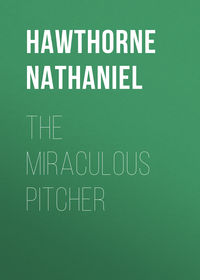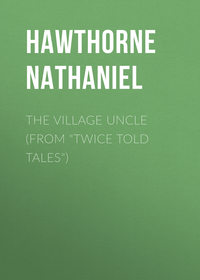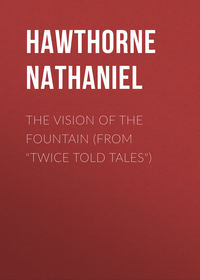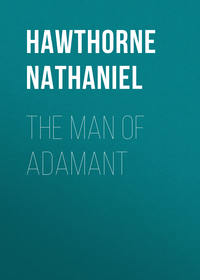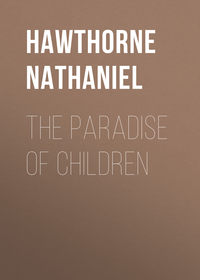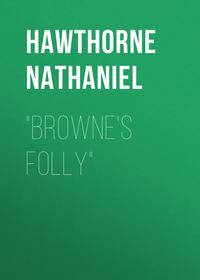 полная версия
полная версияPassages from the French and Italian Notebooks, Complete
I was glad when we left the museum, which, by the by, was piercingly chill, as if the multitude of statues radiated cold out of their marble substance. We might have gone to see the pictures in the Palace of the Conservatori, and S – , whose receptivity is unlimited and forever fresh, would willingly have done so; but I objected, and we went towards the Forum. I had noticed, two or three times, an inscription over a mean-looking door in this neighborhood, stating that here was the entrance to the prison of the holy apostles Peter and Paul; and we soon found the spot, not far from the Forum, with two wretched frescos of the apostles above the inscription. We knocked at the door without effect; but a lame beggar, who sat at another door of the same house (which looked exceedingly like a liquor-shop), desired us to follow him, and began to ascend to the Capitol, by the causeway leading from the Forum. A little way upward we met a woman, to whom the beggar delivered us over, and she led us into a church or chapel door, and pointed to a long flight of steps, which descended through twilight into utter darkness. She called to somebody in the lower regions, and then went away, leaving us to get down this mysterious staircase by ourselves. Down we went, farther and farther from the daylight, and found ourselves, anon, in a dark chamber or cell, the shape or boundaries of which we could not make out, though it seemed to be of stone, and black and dungeon-like. Indistinctly, and from a still farther depth in the earth, we heard voices, – one voice, at least, – apparently not addressing ourselves, but some other persons; and soon, directly beneath our feet, we saw a glimmering of light through a round, iron-grated hole in the bottom of the dungeon. In a few moments the glimmer and the voice came up through this hole, and the light disappeared, and it and the voice came glimmering and babbling up a flight of stone stairs, of which we had not hitherto been aware. It was the custode, with a party of visitors, to whom he had been showing St. Peter's dungeon. Each visitor was provided with a wax taper, and the custode gave one to each of us, bidding us wait a moment while he conducted the other party to the upper air. During his absence we examined the cell, as well as our dim lights would permit, and soon found an indentation in the wall, with an iron grate put over it for protection, and an inscription above informing us that the Apostle Peter had here left the imprint of his visage; and, in truth, there is a profile there, – forehead, nose, mouth, and chin, – plainly to be seen, an intaglio in the solid rock. We touched it with the tips of our fingers, as well as saw it with our eyes.
The custode soon returned, and led us down the darksome steps, chattering in Italian all the time. It is not a very long descent to the lower cell, the roof of which is so low that I believe I could have reached it with my hand. We were now in the deepest and ugliest part of the old Mamertine Prison, one of the few remains of the kingly period of Rome, and which served the Romans as a state-prison for hundreds of years before the Christian era. A multitude of criminals or innocent persons, no doubt, have languished here in misery, and perished in darkness. Here Jugurtha starved; here Catiline's adherents were strangled; and, methinks, there cannot be in the world another such an evil den, so haunted with black memories and indistinct surmises of guilt and suffering. In old Rome, I suppose, the citizens never spoke of this dungeon above their breath. It looks just as bad as it is; round, only seven paces across, yet so obscure that our tapers could not illuminate it from side to side, – the stones of which it is constructed being as black as midnight. The custode showed us a stone post, at the side of the cell, with the hole in the top of it, into which, he said, St. Peter's chain had been fastened; and he uncovered a spring of water, in the middle of the stone floor, which he told us had miraculously gushed up to enable the saint to baptize his jailer. The miracle was perhaps the more easily wrought, inasmuch as Jugurtha had found the floor of the dungeon oozy with wet. However, it is best to be as simple and childlike as we can in these matters; and whether St. Peter stamped his visage into the stone, and wrought this other miracle or no, and whether or no he ever was in the prison at all, still the belief of a thousand years and more gives a sort of reality and substance to such traditions. The custode dipped an iron ladle into the miraculous water, and we each of us drank a sip; and, what is very remarkable, to me it seemed hard water and almost brackish, while many persons think it the sweetest in Rome. I suspect that St. Peter still dabbles in this water, and tempers its qualities according to the faith of those who drink it.
The staircase descending into the lower dungeon is comparatively modern, there having been no entrance of old, except through the small circular opening in the roof. In the upper cell the custode showed us an ancient flight of stairs, now built into the wall, which used to lead from the Capitol. The whole precincts are now consecrated, and I believe the upper portion, perhaps both upper and lower, are a shrine or a chapel.
I now left S – in the Forum, and went to call on Mr. J. P. K – at the Hotel d'Europe. I found him just returned from a drive, – a gentleman of about sixty, or more, with gray hair, a pleasant, intellectual face, and penetrating, but not unkindly eyes. He moved infirmly, being on the recovery from an illness. We went up to his saloon together, and had a talk, – or, rather, he had it nearly all to himself, – and particularly sensible talk, too, and full of the results of learning and experience. In the first place, he settled the whole Kansas difficulty; then he made havoc of St. Peter, who came very shabbily out of his hands, as regarded his early character in the Church, and his claims to the position he now holds in it. Mr. K – also gave a curious illustration, from something that happened to himself, of the little dependence that can be placed on tradition purporting to be ancient, and I capped his story by telling him how the site of my town-pump, so plainly indicated in the sketch itself, has already been mistaken in the city council and in the public prints.
February 24th. – Yesterday I crossed the Ponte Sisto, and took a short ramble on the other side of the river; and it rather surprised me to discover, pretty nearly opposite the Capitoline Hill, a quay, at which several schooners and barks, of two or three hundred tons' burden, were moored. There was also a steamer, armed with a large gun and two brass swivels on her forecastle, and I know not what artillery besides. Probably she may have been a revenue-cutter.
Returning I crossed the river by way of the island of St. Bartholomew over two bridges. The island is densely covered with buildings, and is a separate small fragment of the city. It was a tradition of the ancient Romans that it was formed by the aggregation of soil and rubbish brought down by the river, and accumulating round the nucleus of some sunken baskets.
On reaching the hither side of the river, I soon struck upon the ruins of the theatre of Marcellus, which are very picturesque, and the more so from being closely linked in, indeed, identified with the shops, habitations, and swarming life of modern Rome. The most striking portion was a circular edifice, which seemed to have been composed of a row of Ionic columns standing upon a lower row of Doric, many of the antique pillars being yet perfect; but the intervening arches built up with brickwork, and the whole once magnificent structure now tenanted by poor and squalid people, as thick as mites within the round of an old cheese. From this point I cannot very clearly trace out my course; but I passed, I think, between the Circus Maximus and the Palace of the Caesars, and near the Baths of Caracalla, and went into the cloisters of the Church of San Gregorio. All along I saw massive ruins, not particularly picturesque or beautiful, but huge, mountainous piles, chiefly of brickwork, somewhat tweed-grown here and there, but oftener bare and dreary… All the successive ages since Rome began to decay have done their best to ruin the very ruins by taking away the marble and the hewn stone for their own structures, and leaving only the inner filling up of brickwork, which the ancient architects never designed to be seen. The consequence of all this is, that, except for the lofty and poetical associations connected with it, and except, too, for the immense difference in magnitude, a Roman ruin may be in itself not more picturesque than I have seen an old cellar, with a shattered brick chimney half crumbling down into it, in New England.
By this time I knew not whither I was going, and turned aside from a broad, paved road (it was the Appian Way) into the Via Latina, which I supposed would lead to one of the city gates. It was a lonely path: on my right hand extensive piles of ruin, in strange shapes or shapelessness, built of the broad and thin old Roman bricks, such as may be traced everywhere, when the stucco has fallen away from a modern Roman house; for I imagine there has not been a new brick made here for a thousand years. On my left, I think, was a high wall, and before me, grazing in the road.. [the buffalo calf of the Marble Faun. – ED.]. The road went boldly on, with a well-worn track up to the very walls of the city; but there it abruptly terminated at an ancient, closed-up gateway. From a notice posted against a door, which appeared to be the entrance to the ruins on my left, I found that these were the remains of Columbaria, where the dead used to be put away in pigeon-holes. Reaching the paved road again, I kept on my course, passing the tomb of the Scipios, and soon came to the gate of San Sebastiano, through which I entered the Campagna. Indeed, the scene around was so rural, that I had fancied myself already beyond the walls. As the afternoon was getting advanced, I did not proceed any farther towards the blue hills which I saw in the distance, but turned to my left, following a road that runs round the exterior of the city wall. It was very dreary and solitary, – not a house on the whole track, with the broad and shaggy Campagna on one side, and the high, bare wall, looking down over my head, on the other. It is not, any more than the other objects of the scene, a very picturesque wall, but is little more than a brick garden-fence seen through a magnifying-glass, with now and then a tower, however, and frequent buttresses, to keep its height of fifty feet from toppling over. The top was ragged, and fringed with a few weeds; there had been embrasures for guns and eyelet-holes for musketry, but these were plastered up with brick or stone. I passed one or two walled-up gateways (by the by, the Parts, Latina was the gate through which Belisarius first entered Rome), and one of these had two high, round towers, and looked more Gothic and venerable with antique strength than any other portion of the wall. Immediately after this I came to the gate of San Giovanni, just within which is the Basilica of St. John Lateran, and there I was glad to rest myself upon a bench before proceeding homeward.
There was a French sentinel at this gateway, as at all the others; for the Gauls have always been a pest to Rome, and now gall her worse than ever. I observed, too, that an official, in citizen's dress, stood there also, and appeared to exercise a supervision over some carts with country produce, that were entering just then.
February 25th. – We went this forenoon to the Palazzo Borghese, which is situated on a street that runs at right angles with the Corso, and very near the latter. Most of the palaces in Rome, and the Borghese among them, were built somewhere about the sixteenth century; this in 1590, I believe. It is an immense edifice, standing round the four sides of a quadrangle; and though the suite of rooms comprising the picture-gallery forms an almost interminable vista, they occupy only a part of the ground-floor of one side. We enter from the street into a large court, surrounded with a corridor, the arches of which support a second series of arches above. The picture-rooms open from one into another, and have many points of magnificence, being large and lofty, with vaulted ceilings and beautiful frescos, generally of mythological subjects, in the flat central part of the vault. The cornices are gilded; the deep embrasures of the windows are panelled with wood-work; the doorways are of polished and variegated marble, or covered with a composition as hard, and seemingly as durable. The whole has a kind of splendid shabbiness thrown over it, like a slight coating of rust; the furniture, at least the damask chairs, being a good deal worn, though there are marble and mosaic tables, which may serve to adorn another palace when this one crumbles away with age. One beautiful hall, with a ceiling more richly gilded than the rest, is panelled all round with large looking-glasses, on which are painted pictures, both landscapes and human figures, in oils; so that the effect is somewhat as if you saw these objects represented in the mirrors. These glasses must be of old date, perhaps coeval with the first building of the palace; for they are so much dimmed, that one's own figure appears indistinct in them, and more difficult to be traced than the pictures which cover them half over. It was very comfortless, – indeed, I suppose nobody ever thought of being comfortable there, since the house was built, – but especially uncomfortable on a chill, damp day like this. My fingers were quite numb before I got half-way through the suite of apartments, in spite of a brazier of charcoal which was smouldering into ashes in two or three of the rooms. There was not, so far as I remember, a single fireplace in the suite. A considerable number of visitors – not many, however – were there; and a good many artists; and three or four ladies among them were making copies of the more celebrated pictures, and in all or in most cases missing the especial points that made their celebrity and value. The Prince Borghese certainly demeans himself like a kind and liberal gentleman, in throwing open this invaluable collection to the public to see, and for artists to carry away with them, and diffuse all over the world, so far as their own power and skill will permit. It is open every day of the week, except Saturday and Sunday, without any irksome restriction or supervision; and the fee, which custom requires the visitor to pay to the custode, has the good effect of making us feel that we are not intruders, nor received in an exactly eleemosynary way. The thing could not be better managed.
The collection is one of the most celebrated in the world, and contains between eight and nine hundred pictures, many of which are esteemed masterpieces. I think I was not in a frame for admiration to-day, nor could achieve that free and generous surrender of myself which I have already said is essential to the proper estimate of anything excellent. Besides, how is it possible to give one's soul, or any considerable part of it, to a single picture, seen for the first time, among a thousand others, all of which set forth their own claims in an equally good light? Furthermore, there is an external weariness, and sense of a thousand-fold sameness to be overcome, before we can begin to enjoy a gallery of the old Italian masters… I remember but one painter, Francia, who seems really to have approached this awful class of subjects (Christs and Madonnas) in a fitting spirit; his pictures are very singular and awkward, if you look at them with merely an external eye, but they are full of the beauty of holiness, and evidently wrought out as acts of devotion, with the deepest sincerity; and are veritable prayers upon canvas…
I was glad, in the very last of the twelve rooms, to come upon some Dutch and Flemish pictures, very few, but very welcome; Rubens, Rembrandt, Vandyke, Paul Potter, Teniers, and others, – men of flesh and blood, and warm fists, and human hearts. As compared with them, these mighty Italian masters seem men of polished steel; not human, nor addressing themselves so much to human sympathies, as to a formed, intellectual taste.
March 1st. – To-day began very unfavorably; but we ventured out at about eleven o'clock, intending to visit the gallery of the Colonna Palace. Finding it closed, however, on account of the illness of the custode, we determined to go to the picture-gallery of the Capitol; and, on our way thither, we stepped into Il Gesu, the grand and rich church of the Jesuits, where we found a priest in white, preaching a sermon, with vast earnestness of action and variety of tones, insomuch that I fancied sometimes that two priests were in the agony of sermonizing at once. He had a pretty large and seemingly attentive audience clustered round him from the entrance of the church, half-way down the nave; while in the chapels of the transepts and in the remoter distances were persons occupied with their own individual devotion. We sat down near the chapel of St. Ignazio, which is adorned with a picture over the altar, and with marble sculptures of the Trinity aloft, and of angels fluttering at the sides. What I particularly noted (for the angels were not very real personages, being neither earthly nor celestial) was the great ball of lapis lazuli, the biggest in the world, at the feet of the First Person in the Trinity. The church is a splendid one, lined with a great variety of precious marbles… but partly, perhaps, owing to the dusky light, as well as to the want of cleanliness, there was a dingy effect upon the whole. We made but a very short stay, our New England breeding causing us to feel shy of moving about the church in sermon time.
It rained when we reached the Capitol, and, as the museum was not yet open, we went into the Palace of the Conservators, on the opposite side of the piazza. Around the inner court of the ground-floor, partly under two opposite arcades, and partly under the sky, are several statues and other ancient sculptures; among them a statue of Julius Caesar, said to be the only authentic one, and certainly giving an impression of him more in accordance with his character than the withered old face in the museum; also, a statue of Augustus in middle age, still retaining a resemblance to the bust of him in youth; some gigantic heads and hands and feet in marble and bronze; a stone lion and horse, which lay long at the bottom of a river, broken and corroded, and were repaired by Michel Angelo; and other things which it were wearisome to set down. We inquired of two or three French soldiers the way into the picture-gallery; but it is our experience that French soldiers in Rome never know anything of what is around them, not even the name of the palace or public place over which they stand guard; and though invariably civil, you might as well put a question to a statue of an old Roman as to one of them. While we stood under the loggia, however, looking at the rain plashing into the court, a soldier of the Papal Guard kindly directed us up the staircase, and even took pains to go with us to the very entrance of the picture-rooms. Thank Heaven, there are but two of them, and not many pictures which one cares to look at very long.
Italian galleries are at a disadvantage as compared with English ones, inasmuch as the pictures are not nearly such splendid articles of upholstery; though, very likely, having undergone less cleaning and varnishing, they may retain more perfectly the finer touches of the masters. Nevertheless, I miss the mellow glow, the rich and mild external lustre, and even the brilliant frames of the pictures I have seen in England. You feel that they have had loving care taken of them; even if spoiled, it is because they have been valued so much. But these pictures in Italian galleries look rusty and lustreless, as far as the exterior is concerned; and, really, the splendor of the painting, as a production of intellect and feeling, has a good deal of difficulty in shining through such clouds.
There is a picture at the Capitol, the "Rape of Europa," by Paul Veronese, that would glow with wonderful brilliancy if it were set in a magnificent frame, and covered with a sunshine of varnish; and it is a kind of picture that would not be desecrated, as some deeper and holier ones might be, by any splendor of external adornment that could be bestowed on it. It is deplorable and disheartening to see it in faded and shabby plight, – this joyous, exuberant, warm, voluptuous work. There is the head of a cow, thrust into the picture, and staring with wild, ludicrous wonder at the godlike bull, so as to introduce quite a new sentiment.
Here, and at the Borghese Palace, there were some pictures by Garofalo, an artist of whom I never heard before, but who seemed to have been a man of power. A picture by Marie Subleyras – a miniature copy from one by her husband, of the woman anointing the feet of Christ – is most delicately and beautifully finished, and would be an ornament to a drawing-room; a thing that could not truly be said of one in a hundred of these grim masterpieces. When they were painted life was not what it is now, and the artists had not the same ends in view… It depresses the spirits to go from picture to picture, leaving a portion of your vital sympathy at every one, so that you come, with a kind of half-torpid desperation, to the end. On our way down the staircase we saw several noteworthy bas-reliefs, and among them a very ancient one of Curtius plunging on horseback into the chasm in the Forum. It seems to me, however, that old sculpture affects the spirits even more dolefully than old painting; it strikes colder to the heart, and lies heavier upon it, being marble, than if it were merely canvas.
My wife went to revisit the museum, which we had already seen, on the other side of the piazza; but, being cold, I left her there, and went out to ramble in the sun; for it was now brightly, though fitfully, shining again. I walked through the Forum (where a thorn thrust itself out and tore the sleeve of my talma) and under the Arch of Titus, towards the Coliseum. About a score of French drummers were beating a long, loud roll-call, at the base of the Coliseum, and under its arches; and a score of trumpeters responded to these, from the rising ground opposite the Arch of Constantine; and the echoes of the old Roman ruins, especially those of the Palace of the Caesars, responded to this martial uproar of the barbarians. There seemed to be no cause for it; but the drummers beat, and the trumpeters blew, as long as I was within hearing.
I walked along the Appian Way as far as the Baths of Caracalla. The Palace of the Caesars, which I have never yet explored, appears to be crowned by the walls of a convent, built, no doubt, out of some of the fragments that would suffice to build a city; and I think there is another convent among the baths. The Catholics have taken a peculiar pleasure in planting themselves in the very citadels of paganism, whether temples or palaces. There has been a good deal of enjoyment in the destruction of old Rome. I often think so when I see the elaborate pains that have been taken to smash and demolish some beautiful column, for no purpose whatever, except the mere delight of annihilating a noble piece of work. There is something in the impulse with which one sympathizes; though I am afraid the destroyers were not sufficiently aware of the mischief they did to enjoy it fully. Probably, too, the early Christians were impelled by religious zeal to destroy the pagan temples, before the happy thought occurred of converting them into churches.
March 3d. – This morning was U – 's birthday, and we celebrated it by taking a barouche, and driving (the whole family) out on the Appian Way as far as the tomb of Cecilia Metella. For the first time since we came to Rome, the weather was really warm, – a kind of heat producing languor and disinclination to active movement, though still a little breeze which was stirring threw an occasional coolness over us, and made us distrust the almost sultry atmosphere. I cannot think the Roman climate healthy in any of its moods that I have experienced.
Close on the other side of the road are the ruins of a Gothic chapel, little more than a few bare walls and painted windows, and some other fragmentary structures which we did not particularly examine. U – and I clambered through a gap in the wall, extending from the basement of the tomb, and thus, getting into the field beyond, went quite round the mausoleum and the remains of the castle connected with it. The latter, though still high and stalwart, showed few or no architectural features of interest, being built, I think, principally of large bricks, and not to be compared to English ruins as a beautiful or venerable object.


